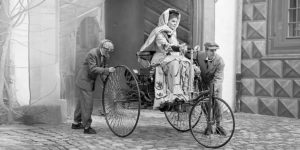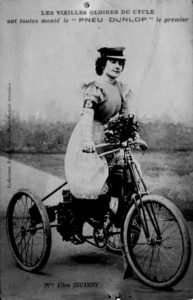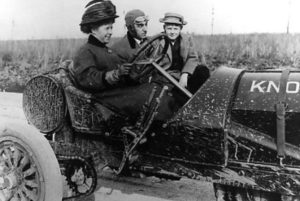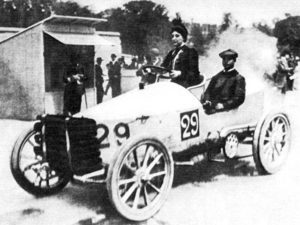 By Hal Tretbar
By Hal Tretbar
Women in Auto Racing: Part 1
Over the next several months I’m going to review the stories of some interesting women and their racecars. This month will be the tales of 19th and early 20th century racing pioneers. The next installment will be about the plucky ladies prior to World War Two. The last will be about the only women driving in Grand Prix and Formula One events after 1950.

From 1880s to the present time women have been involved with fast cars. In 1888 Bertha Benz was interested in her husband Karl’s motorcar invention. She wasn’t afraid to load up the kids for a 50-mile drive to grandma’s house before anyone did road trips. That was on a big tricycle with a fragile motor. She found it was fast going downhill but hard to slow down. So she had leather strips riveted to the brake shoes, long before better braking systems were developed.

In 1897 Lea Lemoine was declared winner of the first all-women’s race. Eight French theatrical ladies from Paris charged around the Longchamps horse track aboard tricycles powered by one horsepower De Dion engines. Lemoine won the same race the next two years.
Over the next several years Belgium Madame Labrouse, with her Panhard, placed 5th in the Brussels-Namur Race and in 1898, Italian Countess Elsa d’Albrizzi was 9th in the Padua- Vicenza-Padua Trail driving a racing Benz.
On the American side of the Big Pond, petite Joan Newman Cuneo (1876-1954) was a successful racecar driver. She was so successful that in 1908 The Contest Board of the American Automobile Association decided to ban women from any of their competitions. They thought it was too difficult for them to handle those big dangerous machines.

Joan married wealthy Andrew Cuneo in 1898. After the birth of two children she became interested in automobiles. She was an excellent driver and also learned the mechanics of her cars. She traded her 1902 steam Locomobile for a more powerful 1905 White steam car.
The big auto event of 1905 was the Glidden Tour. It ran through several states on difficult unpaved roads. Little 5’2’’ Joan Cuneo loaded up her new White auto with her husband, her riding mechanic and his sister to start the Tour. They were enjoying the first day’s drive when the car in front suddenly stopped and began to back up at the entrance to a narrow bridge. Cuneo tried to evade the car but there was little room. The wheels of her White ran off the bridge causing the car with the passengers to fall into the streambed. Fortunately the passengers suffered only bruises. The White was a sturdy machine. It started immediately when it was pulled upright by spectators and they were able to drive her car up out of the ditch. The foursome continued the drive until the battered White gave out on the final day of the Tour. Mrs. Cuneo’s accident made newspaper headlines throughout the Northeast and would launch her career as a racer.
Over the next several years Cuneo entered many different events including those on Fairground oval tracks. She set a number of women’s speed records in straight-line competitions. In 1906 she was driving an obstacle course called a gymkhana when the car caught on fire. She calmly shut off the engine and turned off the gas before jumping out. Although she suffered painful burns and singed hair she shrugged it off as nothing unusual.
She started the summer of 1908 with a perfect score in the Glidden Tour. Then at a series of races over three days at the New Orleans Fairgrounds she beat the best male racers of the time. She finished second to the champion, Ralph De Palma, in a 50-mile event. The resulting flurry of news articles about her successes seemed to upset the Board of The American Automobile Association that led to the banning of female race drivers in their events.
During the next few years Joan Cuneo did less racing. She did set some unofficial speed records and wrote articles for motorcar magazines. She also was a spokesperson for the Good Roads movement.
She eventually divorced Andrew Cuneo and 13 years later married a childhood sweetheart James Sickman. They settled in Michigan to live everyday lives. Her obituary in the local Ontonagon, Michigan paper did not mention her racing career. The New York Times did give her life a brief paragraph.
Last but not least of these earliest accomplished female racecar drivers was Camille du Gast. Her story as shown in Wikipedia is summarized below:
Last but not least of these earliest accomplished female racecar drivers was Camille du Gast. Her story as shown iBut it was Camille du Gast, one of France’s most famous female racing drivers, who became the first to race consistently at the international level. She was born in Paris in 1868. She married a wealthy department store owner who died when she was 27. According to Wikipedia du Gast was known as one of the richest and most accomplished widows in France. She was an excellent balloonist, parachute jumper, fencer, tobogganist, skier, rifle and pistol shot, horse trainer – as well as a concert pianist and singer.
By 1901 she owned both a Peugeot and a Panhard et Levassor that stimulated an interest in racing. She was reported to be the second woman to have a French driver’s license. In that same year, du Gast and Baroness Helene van Zulen were the only two women entrants in the Paris-Berlin race. The Baroness had already competed in the 1898 Paris-Amsterdam-Paris, so du Gast was the second woman in an international race. Her 20 hp Panhard was underpowered yet she finished 33rd of 122 entrants.
In 1902 she competed in the Paris to Vienna race. Her application to enter the New York to San Francisco race was refused because she was a woman.
In 1903 she drove the Paris-Madrid race in a 5.7 liter, 30 hp De Dietrich. During the race two drivers plus at least six spectators were killed. Du Gast had started in 29th position and risen to 8th when she stopped to give first aid to a driver trapped under his car in a ditch. Du Gast was credited with saving his life. She restarted and was in 77th place when the race was stopped.
Madame du Gast was so well known for her daring and competent driving that she managed to become the only woman official of the Automobile Club du France.
The Benz factory team offered her a race seat for the 1904 Gordon Bennett Cup. However the French government had just passed a law that barred women from competing in motor sports, citing ‘feminine nervousness.’ So du Gast decided to race motorboats internationally.
In 1905 du Gast competed in the English Brighton Speed Trials. Her 35 hp car lost to English racer Dorothy Levitt in her 80 hp Napier. After that du Gast became well known for her speedboat competition.

Madame Camille du Gast’s exuberant social and sporting life was changed around 1910 when her daughter attempted to have her killed for inheritance. Du Gast escaped the assassination attempt in the middle of the night by chasing the thugs out of her house.
In the following years du Gast became renowned for her extensive charity work. She provided health care to disadvantaged women and children that continued even under German occupation in World War II. She was president of the French Society for Prevention of Cruelty to Animals until her 1942 death in Paris at age 73.
Sources:
http://www.formula1-dictionary.net/women_in_f1.html
